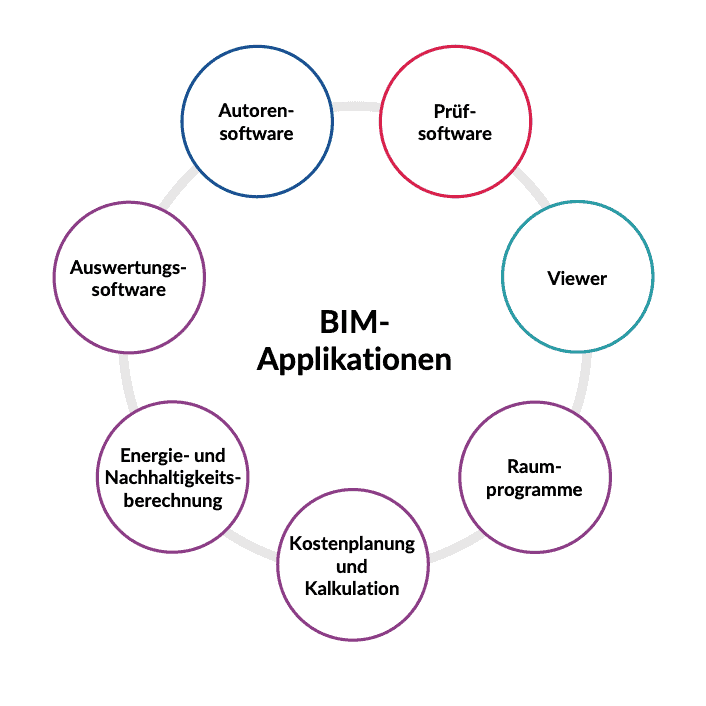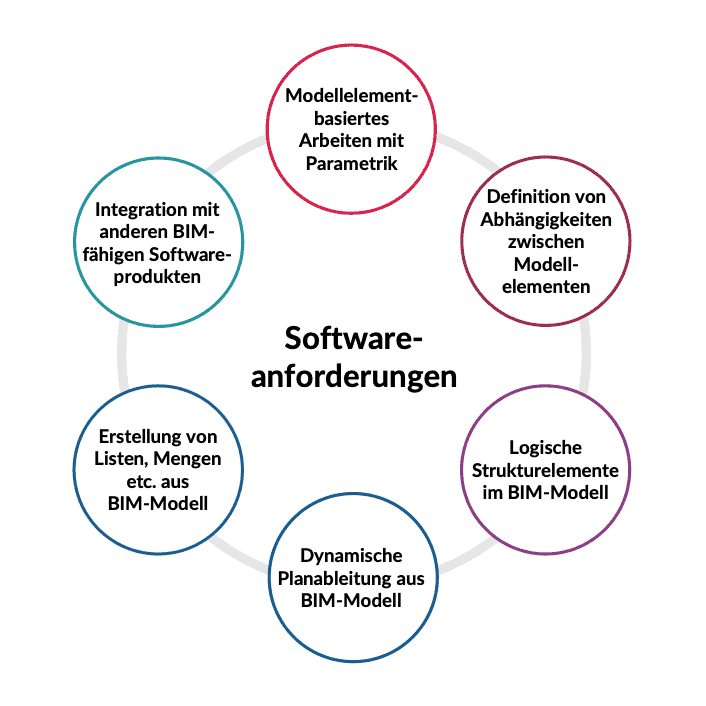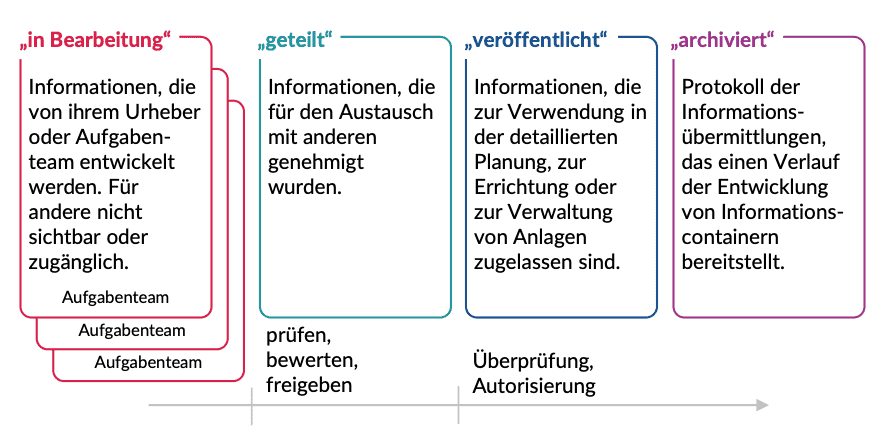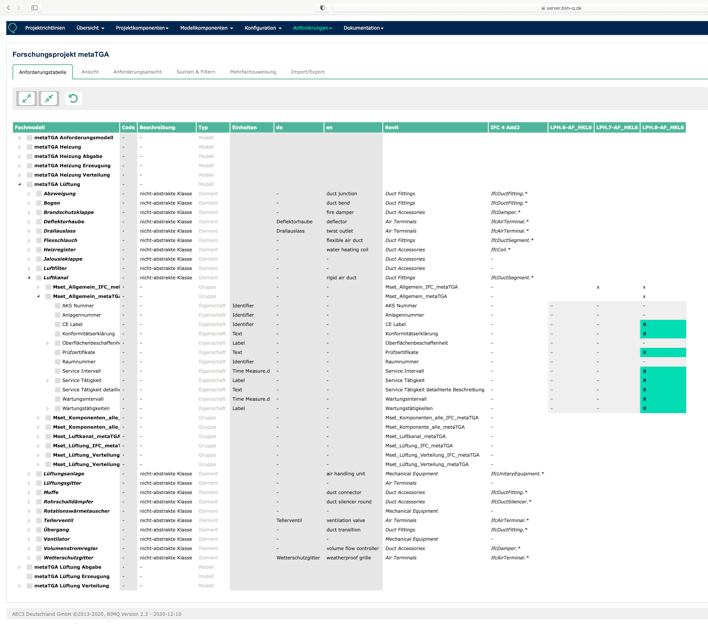A variety of software products are used in BIM. These are summarized under the term BIM tools. This category includes BIM applications, collaboration platforms(Common Data Environment – CDE) and data structure tools.
BIM applications
The term BIM applications refers to those tools that create, check and evaluate model data. A BIM application must meet the requirements and functionalities of the BIM method. Whether an application that is already in use also meets the requirements for openBIM can be found out via its status in the certification by buildingSMART(link).
Certified BIM applications should primarily be used in projects (status = finished). If non-certified BIM applications are used, it must be checked whether the applications can be used with regard to the requirements. These requirements are defined in the regulations(AIA (EIR) and BAP (BEP), see section 2.5.2). Fig. 2.4 provides an overview of the types of BIM applications

The main BIM application is the authoring software. This is where the model content is created according to the respective planning, discipline and BIM organizational unit.
Checking software is an application that only checks model content, but does not change it. It is the most important application for quality management.
A viewer only displays the contents of models, it can neither check nor reuse model information.
The other applications take over model information (checked by checking software and approved by a BIM organizational unit) and use this content for their own uses, calculations and evaluations.
The choice of application should always be carefully considered. Not only the BIM usability (see certification), but also the intended use, acquisition and maintenance costs play a major role here. The following questions must be considered: Is the support provided by the software manufacturer good? Is there a good range of training courses close to the site? The most important requirements for applications (especially with regard to interoperability) are summarized in Fig. 2.5.

A BIM application must therefore
- be able to map, derive and communicate model content in accordance with the IFC data structure/interface (geometric and alphanumeric),
- be able to establish the dependencies between model elements (e.g. floor affiliation of walls and windows in a wall),
- map and read logical structural elements (e.g. TGA systems),
- derive plans dynamically (e.g. in PDF and DWG/DXF formats),
- be able to create evaluation lists of model contents and
- have the functionality to integrate with all other BIM-capable applications and BIM tools that do not come from the same software group.
Collaboration platforms / Common Data Environment CDE
Collaboration platforms are BIM tools that offer web-based services for handling collaboration in projects. They are used to handle project-related communication and data exchange centrally. They offer a common data environment, i.e. a CommonDataEnvironment (CDE). Their major advantage lies in the standardized structuring of project processing (also across projects if required).
CDEs are therefore used for the information management of projects and properties. As central project rooms for the storage and exchange of all project information with all project participants, the entire project knowledge is compactly brought together in them. The project knowledge can be filtered and is quickly available. They offer controlled access (person-dependent, role-specific) to project information, clearly defined exchange processes (workflows) and a clearly defined document and model status. Changes and revisions are logged. This ensures communication transparency and improves the exchange of information. All collaborative activities required to create the PIM (Project Information Model) and AIM (Asset Information Model) take place within the CDE.
ISO 19650 describes the concept of acommon data environment (CDE). According to ISO 19650, a CDE should support three different information container states:
- Work in progress – in progress
- Shared
- Published – published
In addition, an archive container (Archived) should exist, which records all processes of the other information containers in the form of a log (journal of released and published information containers). This enables the development of a combined and collaborative information model.

In addition, comprehensive data security must be guaranteed and the exchange of information must be verified by control instances. During the transfer of information, the data is versioned and logged.
Examples of typical collaboration platforms used in projects for higher-level collaboration are Oracle Aconex, Catenda Hub, Conclude CDE and tpCDE from thinkproject. Integrated collaboration platforms such as Autodesk Construction Cloud or Graphisoft BIMcloud are used for collaboration within a specialist discipline.
Data structure tool
Data structure tools are web-based BIM tools for creating and modifying individual data structures and the levels of detail based on them. For these activities, they offer central moderation and integrated distribution to various channels (BIM applications, BIM rules and regulations, etc.). This minimizes the individual adaptation effort. Data structure tools support the definition of AIA exchange information requirements (EIR) and the creation of project-specific BIM guidelines. They allow direct derivation of the inspection rules for the BIM inspection software. This improves quality management and quality control of the BIM models.

A typical example of a current data structure tool is BIM-Q from AEC3 GmbH. This web application enables
- the creation of individual data structures and assignment of content to different project phases or use cases,
- the creation of corresponding mappings of external data structures (e.g. IFC2x3, IFC4),
- the creation of corresponding mappings of program-specific data structures (e.g. Allplan, Archicad, ProVi, Revit, Vectorworks) and output of the respective configuration files,
- the export/import of all database contents in XLS files for further processing in table editing programs,
- the automatic creation of documents describing the data structure specifications (LOI annex to the exchange information requirements) and
- the automatic creation of bases for test routines for checking the alphanumeric model content in BIM inspection software.
Publication from Eichler, C.C., Schranz, Ch., Krischmann, T., Urban, H., Hopferwieser, M., Fischer, S.: BIMcertHandbuch- Grundlagenwissen openBIM. Issue 2024. Mironde-Verlag, Niederfrohna, 2024. DOI: 10.34726/5384
URL: https://repositum.tuwien.at/bitstream/20.500.12708/192612/3/Eichler-2024-BIMcert %20Handbuch%20basic-knowledge%20openBIM-vor.pdf
Status: 23.01.2024
